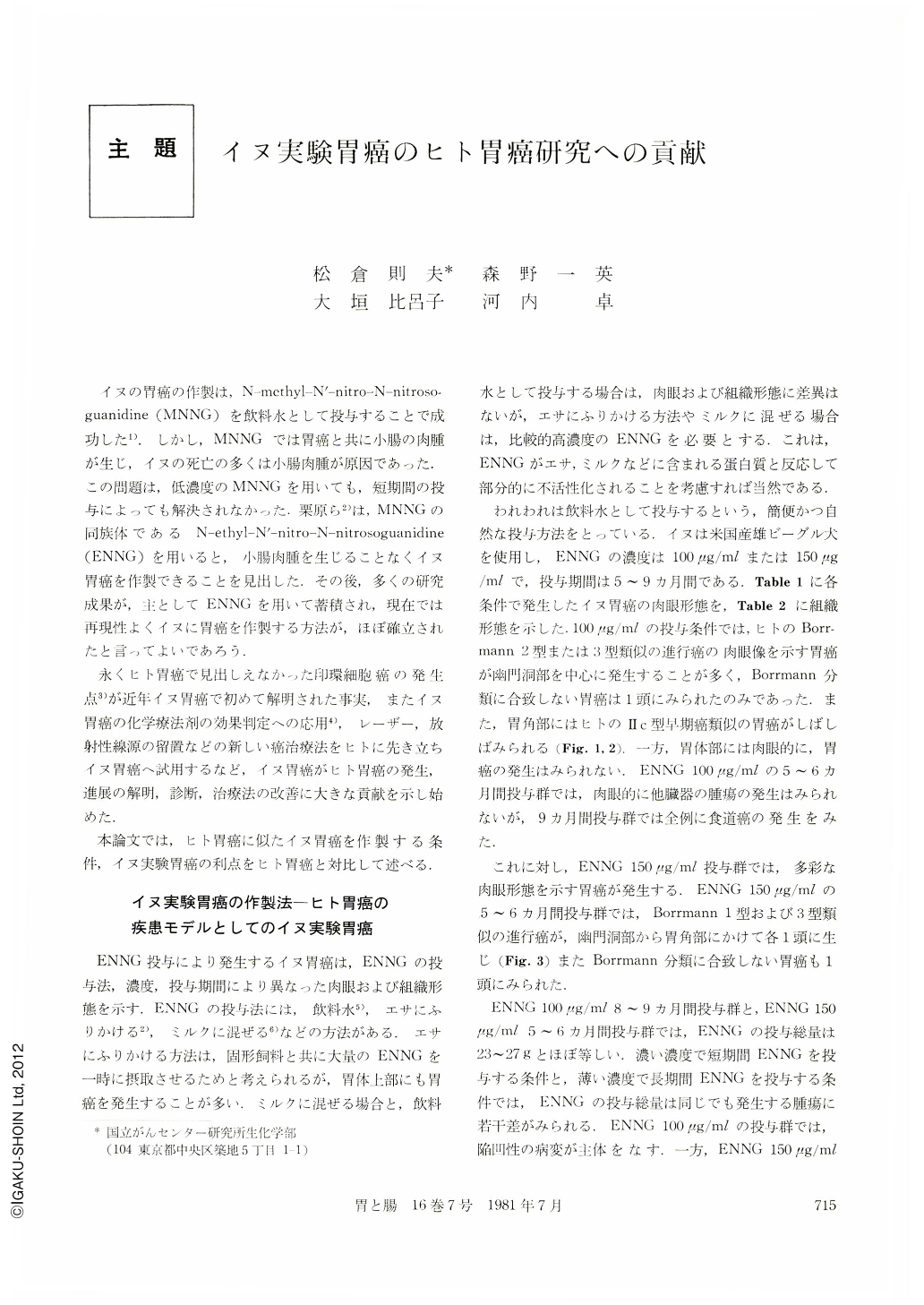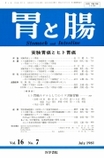Japanese
English
- 有料閲覧
- Abstract 文献概要
- 1ページ目 Look Inside
イヌの胃癌の作製は,N-methyl-N'-nitro-N-nitroso-guanidine(MNNG)を飲料水として投与することで成功した1).しかし,MNNGでは胃癌と共に小腸の肉腫が生じ,イヌの死亡の多くは小腸肉腫が原因であった.この問題は,低濃度のMNNGを用いても,短期間の投与によっても解決されなかった.栗原ら2)は,MNNGの同族体であるN-ethyl-N'-nitro-N-nitrosoguanidine(ENNG)を用いると,小腸肉腫を生じることなくイヌ胃癌を作製できることを見出した.その後,多くの研究成果が,主としてENNGを用いて蓄積され,現在では再現性よくイヌに胃癌を作製する方法が,ほぼ確立されたと言ってよいであろう.
永くヒト胃癌で見出しえなかった印環細胞癌の発生点3)が近年イヌ胃癌で初めて解明された事実,またイヌ胃癌の化学療法剤の効果判定への応用4),レーザー,放射性線源の留置などの新しい癌治療法をヒトに先き立ちイヌ胃癌へ試用するなど,イヌ胃癌がヒト胃癌の発生,進展の解明,診断,治療法の改善に大きな貢献を示し始めた.
Canine gastric carcinoma was induced by N-ethyl-N'-nitro-N-nitrosoguanidine (ENNG) without induction of sarcoma in the small intestine. This gastriccarcinoma in dogs is an animal model of human gastric carcinoma. Fifteen male beagle dogs were given ENNG at the concentration of 100 or 150μg/ml in the drinking water for 5~9 months. Eight dogs given 100μg ENNG/ml showed mainly the depressed-type of early gastric carcinoma and Borrmann type 2 or 3 advanced gastric carcinomas on the gastric angle and the antrum. On the contrary, seven dogs given 150μg ENNG/ml showed mainly the protruded or depressed-type of early gastric carcinoma, Borrmann type 1-like carcinomas and 3 advanced gastric carcinomas on the gastric angle and the antrum with few on the corpus. Thus administration of 100 ug ENNG/ml in the drinking water for 6~8 months is suitable for inducing gastric carcinoma in dogs as an animal model of human gastric carcinoma.
The labeling index (LI) of canine gastric carcinoma induced by administration of ENNG was examined in vivo by pulse injection of [methyl-3H]thymidine intravenously. The Lls of cancerous lesions were lower than those of non-cancerous gastric mucosa or the gastric mucosa of an untreated dog. There were large variations in the Lls in different lesions of the same histological type of carcinoma and also in those in different lesions of individual carcinomas. These variations in Lls were larger in adenocarcinomas of the well differentiated type than in those of the poorly differentiated type. The mean LI of well differentiated adenocarcinomas of the mucosa was significantly higher than that of poorly differentiated adenocarcinomas of the mucosa. The LI decreased with increase in diameter of intramucosal well differentiated adenocarcinomas. On the contrary, it increased with increase in diameter of intra mucosal poorly differentiated adenocarcinomas.
Mucin of canine gastric carcinoma was examined by staining with Alcian blue (pH2.5), periodic acid-Schiff, high iron diamine and paradoxical concanavalin A. Many well or poorly differentiated types of carcinoma cells did not stain for mucin, but some carcinoma cells of these types stained and cells of signet-ring cell carcinomas showed strong staining reactions. Some intramucosal signet-ring cell carcinomas showed a“three-layer structure”; i.e., signetring cells in the upper and lower layers of the mucosa showed a typical signet-ring configuration with much mucin, whereas cancer cells in the middle layer showed large centrally located nuclei with less mucin. Class Ⅲ reactive mucin, found in pyloric gland and mucus neck cells in the normal stomach, was seen in signet-ring cell carcinomas only in the lower layer of the mucosa by paradoxical concanavalin A staining.
Canine gastric carcinoma can be used for tests on chemotherapy and chemo-prevention of gastric car cinoma. Moreover, dogs with gastric carcinoma can be used to test new chemicals or methods of therapy of gastric carcinoma, which cannot be tested in human subjects because they might have severe adverse effects. Canine gastric carcinoma is useful not only in basic research but also in clinical studies on gastric carcinoma.

Copyright © 1981, Igaku-Shoin Ltd. All rights reserved.


